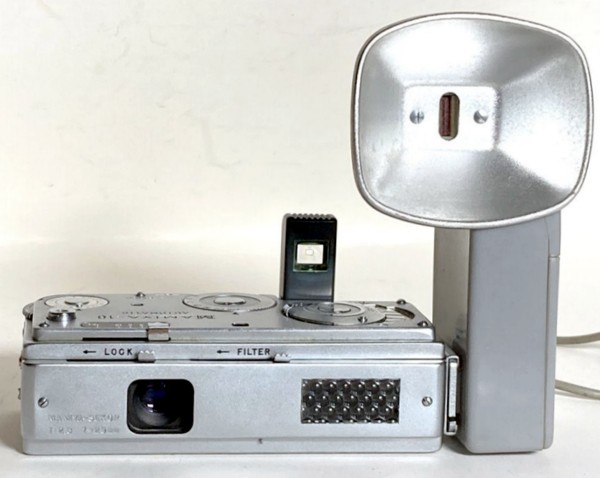
Mamiya 16 Automatic
If you put your hand over the right-half of the camera -- the part with the meter -- you'll see that this camera
is really just a Mamiya Super 16 with a built-in selenium meter. Since the meter took up the space where
the slide-OUT viewfinder used to be, this model had a pop-UP viewfinder on the back. As a result, it was substantially
bigger than the earlier, tiny models. It's called "automatic" due to the built-in "auto"
exposure mode. Most of us would not consider this "auto"-anything, but at the time it was as "automatic"
as you could get. Think of it as shutter-preferred, match-needle, metered-manual exposure. First, dial
in the film speed. Next, the desired shutter speed is selected. Then the exposure dial on the top is
rotated to match up the selected shutter speed with the meter needle. This "automatically" sets
the correct f-stop. That's what "automatic" exposure meant in 1959. In short, it is really
an f-stop dial, but they tried to simplify it but using the same scale as on the shutter speed dial. It worked,
but it confused a lot of people who wanted to work in manual mode -- "OK, but where's the f-stop scale?".
Actually, the set f-stop appears in a tiny window off to the side. The Mamiya 16 Automatic maintained
many of the features of the original Mamiya 16, such as a focusing lens and built-in sliding filter. 25mm
(f2.8-16) lens. Speeds of B, 1/2-1/200. The lens was changed to a slightly faster f2.8 optic with three elements
in three groups. This is the first Mamiya 16 with a standard flash shoe, and a new flash BULB accessory was
availabe, but later electronic FLASH units can also be used. Like most other Mamiya 16 cameras, different
styles exist with minor differences. One type has the same round filter style of the Super series, while
another uses rectangular filters. It was also sold as the Revue 16 Automatic.
COPYRIGHT @ 1995-2024 by Joe McGloin. All Rights Reserved.

